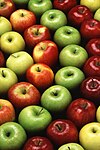A | B | C | D | E | F | G | H | CH | I | J | K | L | M | N | O | P | Q | R | S | T | U | V | W | X | Y | Z | 0 | 1 | 2 | 3 | 4 | 5 | 6 | 7 | 8 | 9
The Rome apple (also known as Red Rome, Rome Beauty, Gillett's Seedling) is a cooking apple originating near Rome Township, Ohio, in the early 19th century. This apple remains popular for its glossy red fruit and for its utility in cooking.
Characteristics
The Rome is rounded, all red, and very glossy, with a thick skin and firm flesh. It is primarily used for baking, as its flavor develops when cooked, and it holds its shape well. It is commonly described as less desirable as an eating apple because of its subtle flavor that is not as sweet, flashy, or tart as some other varieties. It comes to market in late September and is considered a good keeper.[further explanation needed] Rome apples are widely grown and available, and are a staple variety in American commerce.
Origins
The story is given that in 1817 Joel Gillet (also spelled "Gillett" or "Gillette" by his descendants) found a seedling tree in a shipment from a nursery.[1] His son planted the tree on the banks of the Ohio River in Rome Township near Proctorville, Ohio where several years later it was found producing red fruit. His cousin, Horatio Nelson Gillett took cuttings and started a nursery to promote the apple. Originally known as "Gillett's Seedling", it was renamed the "Rome Beauty" in 1832 in honor of the township. The original tree survived into the 1850s until it was felled by erosion of the river bank.
Disease susceptibility
- Scab: high[2]
- Powdery mildew: high
- Cedar-apple rust: high
- Fire blight: high
References
- ^ Kelley, Iris (March 29, 2017). "Hypes volunteered to refurbish sign". Ironton Tribune. Retrieved 2008-02-18.
- ^ Dr. Stephen Miller of the USDA Fruit Research Lab in Kearneysville, West Virginia.[full citation needed]
External links
- "Apple Varieties: Red Rome". New York Apple Association. Retrieved 2008-02-18.
- "Apple Guide". U. S. Apple Association. Archived from the original on 6 December 2010.
- Overley, F.L. (Fall 2007). "From Whence Came: The Varieties of Fruit We Are Now Growing". Connections. Archived from the original on May 30, 2010. Retrieved 2008-02-18.
- Griesan, Jean. "Joel Gillet". The Lawrence Register. Archived from the original on 2008-02-14. Retrieved 2008-02-18.
- National Fruit Collection page
>Text je dostupný pod licencí Creative Commons Uveďte autora – Zachovejte licenci, případně za dalších podmínek. Podrobnosti naleznete na stránce Podmínky užití.
Text je dostupný za podmienok Creative
Commons Attribution/Share-Alike License 3.0 Unported; prípadne za ďalších
podmienok.
Podrobnejšie informácie nájdete na stránke Podmienky
použitia.



